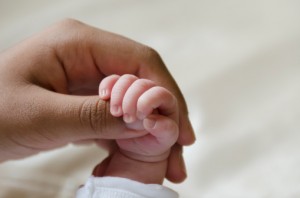Therapy Options for Brachial Plexus Injury
 The brachial plexus is a nerve network that extends from the neck to the shoulder, arm and hand. A brachial plexus injury affects these nerves, which in turn can impact the mobility of the limb. When these injuries occur at birth, often due to a complicated delivery, they might be referred to as a brachial plexus birth palsy or Erb’s Palsy.
The brachial plexus is a nerve network that extends from the neck to the shoulder, arm and hand. A brachial plexus injury affects these nerves, which in turn can impact the mobility of the limb. When these injuries occur at birth, often due to a complicated delivery, they might be referred to as a brachial plexus birth palsy or Erb’s Palsy.
Physical therapy options
Treatment for an injury involving the brachial plexus may vary, based on the severity and type of trauma. Physical therapy is the primary course of treatment for most newborns, before surgical treatment is considered. A physician or physical therapist will teach parents how to perform the exercises with their children to keep the joints flexible and build strength in the arm. Exercises might include various types of massage, positioning and exercise at home.
Physical therapy for brachial plexus injuries must be performed daily in order to yield the best possible results. This makes treatment a very time-consuming process for parents, but necessary in order to avoid deformities as the bones, muscles and joints grow and develop. The good news is most cases of brachial plexus will resolve with regular physical therapy sessions, eliminating the need for surgery in a young child.
Surgical intervention
If improvement is not observed by the time the child reaches 3-6 months of age, surgical intervention may be necessary. Microsurgery, using high-powered microscopes and special tools, is generally used to repair the damaged nerves. Surgery is typically reserved for younger infants and does not usually restore full function to the arm and hand. However, in time, surgery can improve the overall outcome of the injury in a child that is not responding to physical therapy alone.
Even when surgery is recommended, the child will likely need years of physical therapy while the nerves slowly heal and function of the limb returns. Even after treatment, some weakness in the arm and hand can remain. Some children may need additional surgery later on in an effort to restore additional function. Children with these types of injuries are frequent visitors to the pediatrician’s office, so that the injury can be monitored regularly and additional treatment given when appropriate.
Causes of brachial plexus injuries
The cause of a brachial plexus injury can be attributed to a number of factors, including birth trauma. The risk of injury can happen during the birth process, if the baby’s shoulder gets caught behind the mother’s pubic bone in the birth canal, a presentation known as shoulder dystocia. If the complication is not properly handled by hospital staff and undue pressure is placed on the baby’s neck and shoulder, damage to the brachial plexus nerves may result.
Brachial plexus injuries can happen quickly during delivery, but the consequences can be far-reaching and long-lasting. Some children that suffer these injuries never regain full use of their arm and hand, leaving them unable to perform some activities. Treatments for these injuries are usually ongoing and can be quite costly. In some cases arising from malpractice, parents may choose to file a medical negligence lawsuit against hospitals and staff to pursue legal compensation for their child’s injuries and their economic losses.
- Wahpeton Daily News, Some Pediatric Conditions can be Helped with Physical Therapy, http://www.wahpetondailynews.com/health/some-pediatric-conditions-can-be-helped-with-physical-therapy/article_a004a490-0ad0-11e5-9f87-e374fc412a9a.html
- Mayo Clinic, Brachial Plexus Injury, http://www.mayoclinic.org/diseases-conditions/brachial-plexus-injury/diagnosis-treatment/treatment/txc-20127386
- Johns Hopkins Medicine, Brachial Plexus Injury, http://www.hopkinsmedicine.org/neurology_neurosurgery/centers_clinics/peripheral_nerve_surgery/conditions/brachial_plexus_injury_bpi.html
- American Academy of Orthopedic Surgeons, Erb’s Palsy (Brachial Plexus Birth Palsy), http://orthoinfo.aaos.org/topic.cfm?topic=a00077
- Gillette Children’s Hospital, Birth Brachial Plexus Injury, http://www.gillettechildrens.org/conditions-and-care/birth-brachial-plexus-injury/


 Resources
Resources
 Resources
Resources
